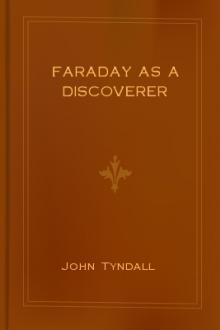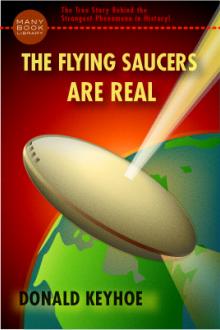Faraday as a Discoverer by John Tyndall (ebook reader with built in dictionary TXT) 📕

- Author: John Tyndall
- Performer: -
Book online «Faraday as a Discoverer by John Tyndall (ebook reader with built in dictionary TXT) 📕». Author John Tyndall
A moment will be granted me to indicate my own view of Faraday’s position here. The word ‘atom’ was not used in the stead of definite proportions, equivalents, or primes. These terms represented facts that followed from, but were not equivalent to, the atomic theory. Facts cannot satisfy the mind: and the law of definite combining proportions being once established, the question ‘why should combination take place according to that law?’ is inevitable. Dalton answered this question by the enunciation of the Atomic Theory, the fundamental idea of which is, in my opinion, perfectly secure. The objection of Faraday to Dalton might be urged with the same substantial force against Newton: it might be stated with regard to the planetary motions that the laws of Kepler revealed the facts; that the introduction of the principle of gravitation was an addition to the facts. But this is the essence of all theory. The theory is the backward guess from fact to principle; the conjecture, or divination regarding something, which lies behind the facts, and from which they flow in necessary sequence. If Dalton’s theory, then, account for the definite proportions observed in the combinations of chemistry, its justification rests upon the same basis as that of the principle of gravitation. All that can in strictness be said in either case is that the facts occur as if the principle existed.
The manner in which Faraday himself habitually deals with his hypotheses is revealed in this lecture. He incessantly employed them to gain experimental ends, but he incessantly took them down, as an architect removes the scaffolding when the edifice is complete.
‘I cannot but doubt,’ he says, ‘that he who as a mere philosopher has most power of penetrating the secrets of nature, and guessing by hypothesis at her mode of working, will also be most careful for his own safe progress and that of others, to distinguish the knowledge which consists of assumption, by which I mean theory and hypothesis, from that which is the knowledge of facts and laws.’ Faraday himself, in fact, was always ‘guessing by hypothesis,’ and making theoretic divination the stepping-stone to his experimental results.
I have already more than once dwelt on the vividness with which he realised molecular conditions; we have a fine example of this strength and brightness of imagination in the present ‘speculation.’
He grapples with the notion that matter is made up of particles, not in absolute contact, but surrounded by interatomic space. ‘Space,’
he observes, ‘must be taken as the only continuous part of a body so constituted. Space will permeate all masses of matter in every direction like a net, except that in place of meshes it will form cells, isolating each atom from its neighbours, itself only being continuous.’
Let us follow out this notion; consider, he argues, the case of a non-conductor of electricity, such for example as shell-lac, with its molecules, and intermolecular spaces running through the mass.
In its case space must be an insulator; for if it were a conductor it would resemble ‘a fine metallic web,’ penetrating the lac in every direction. But the fact is that it resembles the wax of black sealing-wax, which surrounds and insulates the particles of conducting carbon, interspersed throughout its mass. In the case of shell-lac, therefore, space is an insulator.
But now, take the case of a conducting metal. Here we have, as before, the swathing of space round every atom. If space be an insulator there can be no transmission of electricity from atom to atom. But there is transmission; hence space is a conductor. Thus he endeavours to hamper the atomic theory. ‘The reasoning,’ he says, ‘ends in a subversion of that theory altogether; for if space be an insulator it cannot exist in conducting bodies, and if it be a conductor it cannot exist in insulating bodies. Any ground of reasoning,’ he adds, as if carried away by the ardour of argument, ‘which tends to such conclusions as these must in itself be false.’
He then tosses the atomic theory from horn to horn of his dilemmas.
What do we know, he asks, of the atom apart from its force?
You imagine a nucleus which may be called a, and surround it by forces which may be called m; ‘to my mind the a or nucleus vanishes, and the substance consists in the powers of m. And indeed what notion can we form of the nucleus independent of its powers?
What thought remains on which to hang the imagination of an a independent of the acknowledged forces?’ Like Boscovich, he abolishes the atom, and puts a ‘centre of force’ in its place.
With his usual courage and sincerity he pushes his view to its utmost consequences. ‘This view of the constitution of matter,’
he continues, ‘would seem to involve necessarily the conclusion that matter fills all space, or at least all space to which gravitation extends; for gravitation is a property of matter dependent on a certain force, and it is this force which constitutes the matter.
In that view matter is not merely mutually penetrable;[1] but each atom extends, so to say, throughout the whole of the solar system, yet always retaining its own centre of force.’
It is the operation of a mind filled with thoughts of this profound, strange, and subtle character that we have to take into account in dealing with Faraday’s later researches. A similar cast of thought pervades a letter addressed by Faraday to Mr. Richard Phillips, and published in the ‘Philosophical Magazine’ for May, 1846. It is entitled ‘Thoughts on Ray-vibrations,’ and it contains one of the most singular speculations that ever emanated from a scientific mind. It must be remembered here, that though Faraday lived amid such speculations he did not rate them highly, and that he was prepared at any moment to change them or let them go. They spurred him on, but they did not hamper him. His theoretic notions were fluent; and when minds less plastic than his own attempted to render those fluxional images rigid, he rebelled. He warns Phillips moreover, that from first to last, ‘he merely threw out as matter for speculation the vague impressions of his mind; for he gave nothing as the result of sufficient consideration, or as the settled conviction, or even probable conclusion at which he had arrived.’
The gist of this communication is that gravitating force acts in lines across space, and that the vibrations of light and radiant heat consist in the tremors of these lines of force. ‘This notion,’
he says, ‘as far as it is admitted, will dispense with the ether, which, in another view is supposed to be the medium in which these vibrations take place.’ And he adds further on, that his view ‘endeavours to dismiss the ether but not the vibrations.’ The idea here set forth is the natural supplement of his previous notion, that it is gravitating force which constitutes matter, each atom extending, so to say, throughout the whole of the solar system.
The letter to Mr. Phillips winds up with this beautiful conclusion:—
‘I think it likely that I have made many mistakes in the preceding pages, for even to myself my ideas on this point appear only as the shadow of a speculation, or as one of those impressions upon the mind which are allowable for a time as guides to thought and research. He who labours in experimental inquiries, knows how numerous these are, and how often their apparent fitness and beauty vanish before the progress and development of real natural truth.’
Let it then be remembered that Faraday entertained notions regarding matter and force altogether distinct from the views generally held by scientific men. Force seemed to him an entity dwelling along the line in which it is exerted. The lines along which gravity acts between the sun and earth seem figured in his mind as so many elastic strings; indeed he accepts the assumed instantaneity of gravity as the expression of the enormous elasticity of the ‘lines of weight.’ Such views, fruitful in the case of magnetism, barren, as yet, in the case of gravity, explain his efforts to transform this latter force. When he goes into the open air and permits his helices to fall, to his mind’s eye they are tearing through the lines of gravitating power, and hence his hope and conviction that an effect would and ought to be produced. It must ever be borne in mind that Faraday’s difficulty in dealing with these conceptions was at bottom the same as that of Newton; that he is in fact trying to overleap this difficulty, and with it probably the limits prescribed to the intellect itself.
The idea of lines of magnetic force was suggested to Faraday by the linear arrangement of iron filings when scattered over a magnet.
He speaks of and illustrates by sketches, the deflection, both convergent and divergent, of the lines of force, when they pass respectively through magnetic and diamagnetic bodies. These notions of concentration and divergence are also based on the direct observation of his filings. So long did he brood upon these lines; so habitually did he associate them with his experiments on induced currents, that the association became ‘indissoluble,’ and he could not think without them. ‘I have been so accustomed,’ he writes, ‘to employ them, and especially in my last researches, that I may have unwittingly become prejudiced in their favour, and ceased to be a clear-sighted judge. Still, I have always endeavoured to make experiment the test and controller of theory and opinion; but neither by that nor by close cross-examination in principle, have I been made aware of any error involved in their use.’
In his later researches on magne-crystallic action, the idea of lines of force is extensively employed; it indeed led him to an experiment which lies at the root of the whole question. In his subsequent researches on Atmospheric Magnetism the idea receives still wider application, showing itself to be wonderfully flexible and convenient. Indeed without this conception the attempt to seize upon the magnetic actions, possible or actual, of the atmosphere would be difficult in the extreme; but the notion of lines of force, and of their divergence and convergence, guides Faraday without perplexity through all the intricacies of the question. After the completion of those researches, and in a paper forwarded to the Royal Society on October 22, 1851, he devotes himself to the formal development and illustration of his favourite idea. The paper bears the title, ‘On lines of magnetic force, their definite character, and their distribution within a magnet and through space.’
A deep reflectiveness is the characteristic of this memoir.
In his experiments, which are perfectly beautiful and profoundly suggestive, he takes but a secondary delight. His object is to illustrate the utility of his conception of lines of force.
‘The study of these lines,’ he says, ‘has at different times been greatly influential in leading me to various results which I think prove their utility as well as fertility.’
Faraday for a long period used the lines of force merely as ‘a representative idea.’ He seemed for a time averse to going further in expression than the lines themselves, however much further he may have gone in idea. That he believed them to exist at all times round a magnet, and irrespective of the existence of magnetic matter, such as iron filings, external to the magnet, is certain.
No doubt the space round every magnet presented itself to his imagination as traversed by loops of magnetic power; but he was chary in speaking of the physical substratum of those loops. Indeed it may be doubted whether the physical theory of lines of force presented itself with any distinctness to his own mind.
The possible complicity of the luminiferous ether in magnetic





Comments (0)